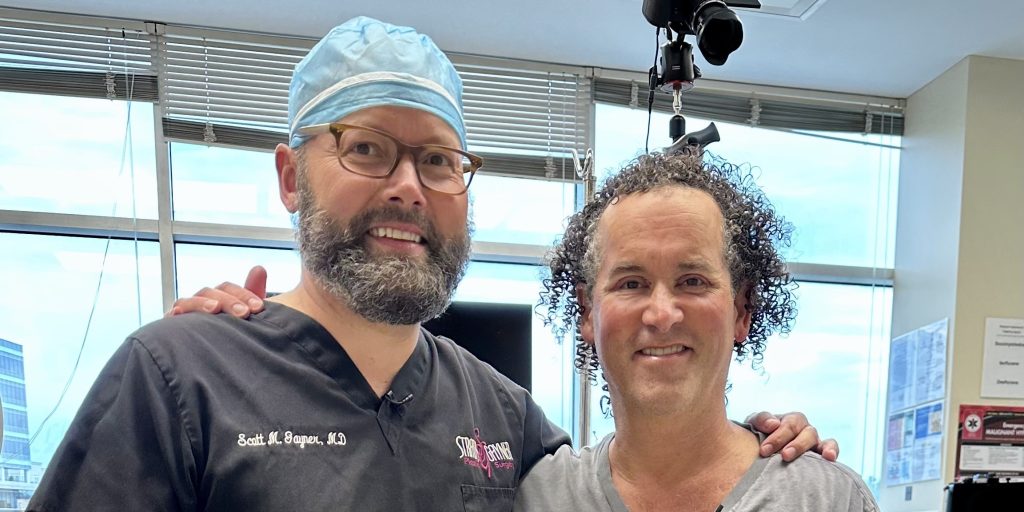Surgical Spotlight: Dr. Gayner’s Upper Blepharoplasty on Fellow Surgeon Dr. Mendelsohn
In a notable instance of professional collaboration, Dr. Scott Gayner, an esteemed facial plastic surgeon, performed an upper blepharoplasty on Dr. Jon Mendelsohn, his colleague and fellow expert in the field. This procedure, involving the delicate art of eyelid surgery, offers a fascinating glimpse into the dynamics of peer-to-peer medical care and the precision required for such specialized surgeries.
Understanding Upper Blepharoplasty
Upper Blepharoplasty: This surgical procedure focuses on the upper eyelids, typically to address issues such as drooping or excess skin, which can impact vision and appearance. The goal is to rejuvenate the eyes by removing excess tissue, tightening the skin, and creating a more youthful and alert look. It is a common procedure performed for both cosmetic and functional reasons.
The Surgeons Involved
Dr. Scott Gayner: Dr. Gayner is renowned for his expertise in facial plastic surgery, including blepharoplasty. His reputation is built on a combination of advanced surgical techniques and a patient-centered approach, making him a sought-after specialist for such procedures.
Dr. Jon Mendelsohn: Dr. Mendelsohn is also a prominent figure in facial plastic surgery, known for his contributions to cosmetic and reconstructive procedures. His decision to undergo surgery by Dr. Gayner highlights the high level of trust and mutual respect within their professional relationship.
The Dynamics of Performing Surgery on a Peer
- Heightened Trust: The decision for Dr. Mendelsohn to have Dr. Gayner perform his surgery underscores an extraordinary level of trust. For Dr. Mendelsohn, choosing a colleague reflects confidence in Dr. Gayner’s surgical skill and judgment.
- Professional Collaboration: The collaborative nature of this scenario highlights the professional respect and camaraderie between the two surgeons. Both are well-versed in the intricacies of facial plastic surgery, which likely facilitated clear communication and a shared understanding of the procedure.
- Emotional and Psychological Factors: Operating on a colleague can introduce unique emotional and psychological factors. Dr. Gayner had to manage the added pressure of performing surgery on a peer who understands the complexities of the procedure. Conversely, Dr. Mendelsohn’s awareness of surgical nuances may have influenced his expectations and interactions with Dr. Gayner.
Reflections on the Experience
- Enhanced Empathy: Dr. Mendelsohn’s experience as a patient underlines the empathy and patient-centered care that is central to a surgical practice. His insights as a fellow surgeon might have informed a more nuanced approach to his own care.
- Standards of Care: The successful outcome of the surgery exemplifies the high standards of care and precision that define the field of facial plastic surgery. The meticulous approach taken by Dr. Gayner ensures that even with the added complexity of a peer-to-peer situation, the quality of care remains exemplary.
- Professional Impact: This instance serves as a powerful example of the mutual respect and professionalism that characterize the medical community. It demonstrates how even the most experienced professionals seek out and value the expertise of their peers.
Conclusion
The upper blepharoplasty performed by Dr. Scott Gayner on Dr. Jon Mendelsohn offers a unique window into the world of facial plastic surgery from the perspective of esteemed colleagues. It highlights the profound trust and respect that exist within the field, as well as the exceptional skill required to perform such precise procedures. This case not only showcases the collaborative spirit of the medical community but also underscores the commitment to excellence that drives top-tier surgical practice. In the end, it’s a compelling reminder of the shared dedication to achieving optimal patient outcomes, regardless of professional status. Check out this video showcasing the process and experience.


Leave a Reply